
Five Writers on How Writing with Creative Constraints Unlocked Their Projects
From Dashiel Carrera, Matthew Vollmer, Matthew Tomkinson, Julie Carr, and Jean Marc Ah-Sen
I have long been an anxious writer. Every sentence written reminds me of the hundreds more that could have stood in its place, missed opportunities for assonance or characterization, clauses left dependent that could have—should have—been made independent. Often it takes all the perseverance I can muster not to leap up and gaze out the window, or better yet, flip open a book by somebody who’s already figured it all out.
For me, the anxiety of writing is the anxiety of possibility. Musical performance—despite all its lore of stage-fright, jitters, and choking—has been my salvation. When performing in front of an audience, a wrong note can’t be taken back; the audience hears it immediately. I find this precariousness strangely freeing. Rather than obsessing over what was previously played, I’m forced to move forward, adapt, and accept my failings. Mistakes become opportunities; a wrong note may suddenly evoke some new cluster of tones I wouldn’t have found otherwise, or veer a solo into provocative territory.
When I began composing The Deer (Dalkey Archive Press), I started to think of my writing sessions as a form of musical performance. I began each session with a clock next to me, forcing myself to hit a word count before the alarm buzzed. The incredible pressure of this process no doubt influenced the mental state of The Deer’s protagonist—panicked, confused, full of dread—but his voice was able to take on an independence and agency I wouldn’t have otherwise thought possible. Without the time to go back and tinker with the language as I wrote, I began to “play” the narrator’s voice like I might a musical instrument, guiding his focus but leaving the idiosyncratic timbre and cadence of his voice intact. Adding a time constraint helped me step out of my own way and give The Deer’s narrator room to breathe.
Because I had such luck using creative constraints, the past few months I’ve been learning more about their history. In literature, creative constraints are often self-imposed. Novels are written without the letter “e,” literary works are written to read the same backwards as forwards, and poems are written such that they can be rearranged into billions of possible permutations. More recently I’ve been talking with other contemporary writers who use constraints, and discovered that what constitutes a constraint is often more ambiguous than in these classic examples. I was asked: doesn’t every artistic process involve constraints? Aren’t we constrained by our responsibilities, our limited energies, and the finite words in the English language?
“I am often drawn to constraint-based approaches for this very reason: namely, because they give something back.”
For writers, it may be the case that the magic of creative constraints doesn’t lie in the constraints themselves but in the ways in which they counteract some deleterious impulse. The creative constraint may also be a means of helping writers understand the wants and needs of a particular project. Certainly for the five projects in this collection—spanning the genres of fiction, poetry, and creative nonfiction—creative constraints elucidated the shifting boundaries that circumscribed the writing process, and revealed a path forward.
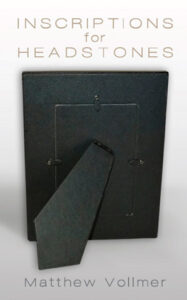
Matthew Vollmer, Inscriptions for Headstones
(Outpost 19)
So about ten years ago I realized that, in the same way that an art teacher might give her students specific assignments, like “paint that bowl of fruit” or “draw an abstraction of a nude body” or “try to produce a photorealistic rendering of a spilled glass of orange juice,” I too could ask my students to write specific and formally innovative writing exercises, like “write a story in the form of a monologue” or “write a story in second person” or “write a story in first person plural” or “write a story in the form of instructions” or “write a story in the form of an epitaph,” the latter of which inspired me to imagine how subverting that particular form would require a writer to make decisions about retaining the epitaph’s distinctive conventions or not, and so with this in mind, I decided to write multiple epitaphs (instead of just one) from a third person perspective and to begin each epitaph with a phrase that would signal to the reader that we were undoubtedly in epitaph territory, like “here lies X” or “R.I.P. Y” or “this stone marks the final resting place of Z,” and instead of preserving the inherently pithy quality of the form, which often seemed to relay only the most basic of information regarding the deceased—like “beloved father and husband”—I chose to write a number of very long-winded and serpentine epitaphs that announced and then explored something idiosyncratic about myself—for example, “here lies a man who wasn’t always nice to his son” or “here lies a man who didn’t always want to take his dog for a walk” or “here lies a man who as a child used to like to imagine when he was in the shower that he was one of the humans who’d declined an invitation into Noah’s Ark and was therefore hours away from being overtaken by floodwaters”—and then afterwards kind of allowed each narrative to cascade and wander and digress until it found a place to land, and so in this way I generated epitaph after epitaph for myself, each one unfolding in a single sentence, a limitation that was quite liberating and proved—to me anyway—that it was true what painter David Hockney once said, which was that, “if you were told to make a drawing of a tulip using five lines or one using a hundred, you’d be more inventive with the five,” an aphorism I find myself often repeating, because I wholeheartedly believe that whatever artistic constraints you as a writer decide to assign yourself or your students—like, say, write a really long sentence—you will reap benefits and be surprised, and if you doubt me try it for yourself and see.
–Matthew Vollmer
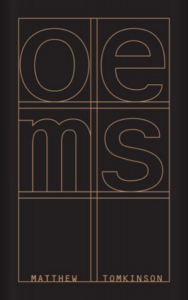
Matthew Tomkinson, oems
(Guernica Editions)
My forthcoming poetry collection, oems, is something of an exercise in data management. Before writing anything, I first resolved to flatten the dictionary. This entailed copy-pasting the contents of the Merriam Webster into a spreadsheet, and then removing all words containing tall letters (b, d, f, g, h, j, k, l, p, q, t, y). What remained was a curated list of flat words such as “sunrise” and “consciousness,” with which I composed the book. In essence, then, my chosen form fits the definition of a lipogram (a work that omits certain letters).
For a long time, I wrote under this constraint without knowing whether it had an official name. Before the industrial era of spreadsheets, I would sit with my friend Geoffrey D. Morrison and try to spontaneously brainstorm a list of flat words, or “smooths,” as we called them then. Some of these early experiments appear in our collaborative book of short fiction, Archaic Torso of Gumby. For the new book, I have sculpted a series of thirty-six flattened poems, whose language veers at times toward jargon (“excimer ions”) and, frequently, toward irreverent humor (“minnie mouse on ice”). Meanwhile, the lipogrammatic imagination seems to inevitably drift, like a river tube rental group, toward “waves,” “oceans,” “seas,” and so on. One of the more freeing aspects of my process was the use of chance operations (spreadsheet formulas) to generate random combinations of flat words, which would help steer the poems in unexpected directions. In one instance, for example, I was greeted by the phrase “anurous caiman,” and the image of a tailless lizard seemed rather fitting for a book that eschews typographical tails.
I am often drawn to constraint-based approaches for this very reason: namely, because they give something back. They provide a certain level of texture against which a metaphorical match can more easily be struck. Moreover, they tend to save me from the unnameable pain of waiting to have an idea. The “prisoner’s constraint,” as the Oulipian writer Paul Fournel calls it, is based on the idea that a resourceful inmate might use flat words in order to fit more of them onto a small scrap of paper. But this analogy strikes me as needlessly oppressive, utilitarian. Indeed, one of the personal subtexts throughout the book is my attempt to transfigure OCD by leaning into formal fixations (so-called “monomania”) and to ultimately unsee this condition as a kind of mental prison, but instead: a conceptual playground.
–Matthew Tomkinson
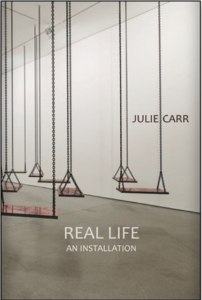
Julie Carr, Real Life: An Installation
(Omnidawn)
I write, I think, for maximal freedom, maximal movement. But the body is constrained by its own borders: its form, its skin, its genre. Being in a body, being in a genre, is so often about wanting out. How can I be other than I seem to myself? Other than I seem to others? How can I write beyond the borders of the page, the borders of my language, of my imagination? I used to dance and wish I had more limbs, softer joints, that my front would be my back and my inside my out. But the only way to get to the ecstasy of exceeding oneself was, paradoxically, by constraining oneself. Give the body a task, a pattern to repeat (in dance, as in writing, this is called a “phrase”).
Repetition becomes a form of deep study, as one discovers the seemingly infinite room within the room the rules make. “The islands feel the enclasping flow, / And then their endless bounds they know,” the Victorian poet Matthew Arnold wro in a poem called “To Marguerite—Continued.” Here the island, as a metaphor for the body, knows its own limits when it is constrained, “enclasped,” by an external entity, an “order” or a “rule” (Arnold uses both these words in the next stanza). And yet, Arnold is punning. The word “bound,” when a verb, means to leap, maybe to leap across, to move with energy and freedom. The very same force that creates a boundary also allows for endless movement.
When I was writing a book with a maximalist impulse, Real Life: An Installation, I would sometimes find myself paralyzed by too much freedom. I’d given myself some rules to write by, but because I wanted the writing to stay as close to the chaos of “real life” as possible, the rules were loose, the boundaries wide. One day in a moment of confusion, I fund myself numbering my lines. When I got to fourteen, the number of lines in a sonnet, I stopped. I titled the poem “Into it,” for it had allowed me back “in” to the writing. I found that within the cool comfort of the 14-line limit, I could pack almost anything I wanted. Like a child in a playground, the poem felt protected, even as it went wild. “The real renews itself each year/ I’ll do whatever the radios suggest,” I wrote in lines numbered 4 and 5. After that, I wrote dozens of fourteen-line poems, each with their lines deliberately numbered. Propulsive motion had a clearly demarked beginning and end; “enclasped” by counting, my language, by which I mean my body, could once again move.
–Julie Carr
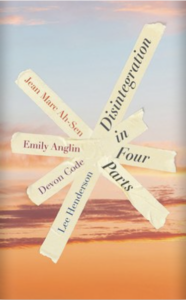
Jean Marc Ah-Sen, Disintegration in Four Parts
(Coach House Books)
Disintegration in Four Parts was a “collaborative omnibus novel” I put together with fellow Canadian novelists Lee Henderson, Emily Anglin, and Devon Code. I had quit writing as a professional activity in 2016, but I came out of “retirement” for a story collection called In the Beggarly Style of Imitation. I felt burned out but pressured to follow it up quickly. I was thinking a novella might be the best solution, but I was worried about the market hostility to an otherwise creatively fertile form.
I found the solution to my problem in Ro.Go.Pa.G., the anthology film Roberto Rossellini, Jean-Luc Godard, Pier Paolo Pasolini, and Ugo Gregoretti produced together in 1963. I wondered if I could borrow this arrangement and half-jokingly spearhead a “CanLit supergroup.” Like the film, the book would be collaborative, but also betoken a persevering individualism and unity of vision. I wanted to ape the film’s boundary-testing éclat and see if a voyage to the edge could finally dock in the liminal spaces between novel, novella, and anthology.
I came up with a quote that could rally potential writers together—“all purity is created by resemblance and disavowal”—and then sought out the best literary fiction practitioners I knew to interpret the cryptic dictum. We individually abided by a 10,000 word count and an ambitious four month deadline. These constraints were really on account of my unfledged status in writing. I thought I could turn this project into a “clinker-built” writing apprenticeship for myself, where my work could somehow overlap with others and participate in the rigors of a creative writing program. My writing is for the most part improvisational and aleatory, but the quote and word count helped bring focus to my efforts—it pushed me to ensure that each sentence pointilistically contributed to the theme I forced us to tackle. In this respect, my piece became less character-driven and more symbolically oriented, for better or for worse.
Having access to Lee, Emily, and Devon’s processes was a blessing, in part because we were accountable to each other—writer’s block becomes less of a problem when someone is depending on you to finish a story so that you can start pitching a book together, which was exactly the kind of dogged motivation I needed to ensure I would not abandon writing a second time.
–Jean Marc Ah-Sen
__________________________________
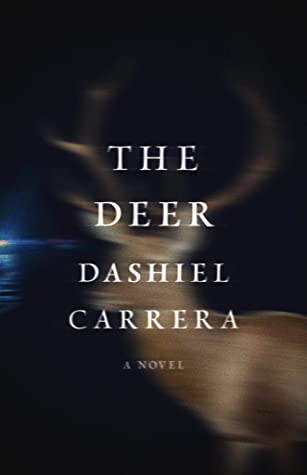
The Deer, by Daniel Carrera, is available now from Dalkey Archive.
Dashiel Carrera
Dashiel Carrera is the author of The Deer (September 2022, Dalkey Archive Press). His writing appears or is forthcoming in Los Angeles Review of Books, LitHub, FENCE, BOMB, Brooklyn Rail and others. Also a musician, he has released 5 albums on the label 75OrLessRecords. He is currently a PhD student in Human-Computer Interaction at the University of Toronto.



















